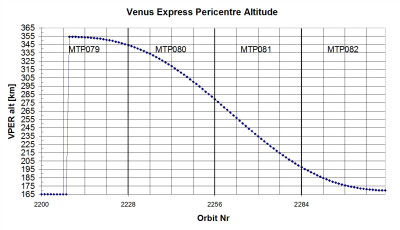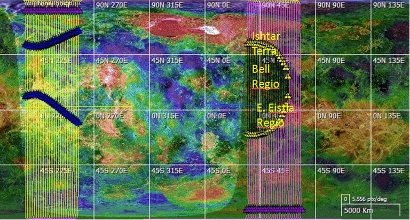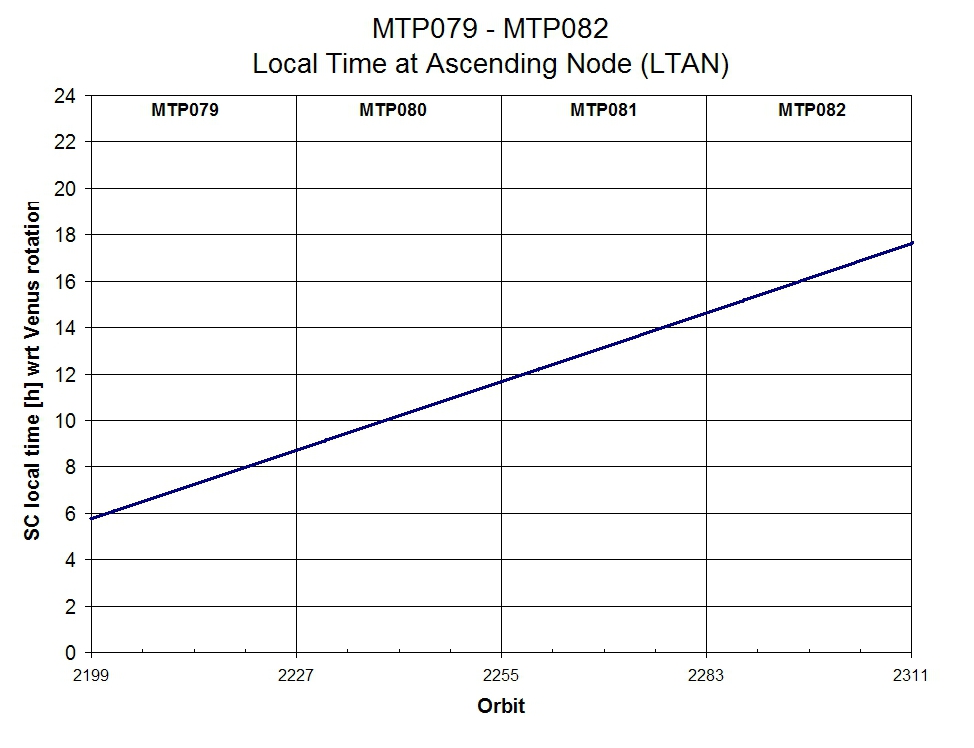No. 249 - Continuation of the thirteenth Earth occultation season and end of the twenty-first eclipse season
Continuation of the thirteenth Earth occultation season
The thirteenth Earth occultation season, which started on 27 March 2012, continued throughout this reporting period. It is the mission's longest occultation season and will end on 6 October 2012.
During occultation seasons, the relative alignment of the Earth, Venus and the orbit of Venus Express, can be exploited to study Venus' atmosphere with the Venus Radio Science experiment (VeRa). Occultation measurements are performed with VeRa at the pericentre of each orbit.
During this reporting period, occultation measurements were taken in 11 successive orbits (between 24 June and 4 July), and then 8 more times, in every second orbit, up to 20 July.
The VeRa measurements were given higher priority, when competing with other potential observations around the pericentre, because temperature soundings with VeRa were highly desired at the latitude (about 20° North) that could be observed during the occultations in this reporting period.
For more information about Earth occultation seasons, see the link in the right-hand column.
Orbit control manoeuvres
Two scheduled orbital control manoeuvres (OCMs) were performed during this reporting period, in preparation for the upcoming Atmospheric Drag Experiment (ADE) #9 campaign in the next reporting period.
The first OCM was executed successfully on 15 July, at pericentre, to increase the height of the apocentre (furthest point of the orbit from Venus).
The second OCM was a navigation manoeuvre and was executed successfully on 17 July, at apocentre, to adjust the angle of the spacecraft's orbital plane around the planet.
Subsequent tracking of the spacecraft confirmed the combined performance of the two manoeuvres had been very good; the actual change in the orbit period was within 0.5 seconds of the planned value.
 |
|
Change in Venus Express pericentre altitude (28 April to 18 August 2012). Credit: ESA |
DDOR high accuracy spacecraft ranging
ESA's Cebreros and New Norcia ground stations were used for a Delta Differential One-way Ranging (delta-DOR, or DDOR) measurement at the start of the Cebreros communications pass on 14 July. These measurements are carried out with the Venus Express spacecraft on a regular basis to support the accurate determination of the ephemeris for the planet Venus that is maintained by NASA's Solar System Dynamics Group.
For more information about DDOR, see the "Delta-DOR measurements" link in the right-hand column.
Leap Second
Leap seconds are occasionally required to keep UTC (a uniform time scale defined by atomic clocks) within one second of the UT1 time scale (based on Earth's actual daily rotation), because the latter is slowly varying. This is coordinated by the International Earth Rotation and Reference Systems Service (IERS).
In January of 2012, the IERS announced the insertion of a leap second in the night from Saturday 30 June to Sunday 1 July 2012. The leap second was inserted in the spacecraft timing for Venus Express without any problems.
Time correlation performed
The clock on the Venus Express spacecraft is actually a count-up timer, typical of those used on spacecraft. These clocks save weight and cost but they tend to drift and at regular intervals have to be synchronised - or correlated - with atomic clocks on Earth. One of these regular time correlations was performed immediately after the communications pass with the Cebreros ground station on 25 June. The new time correlation was applied from then onwards.
Battery charging modified
During solar eclipse seasons, the spacecraft is in complete darkness during a portion of each orbit when Venus blocks out the Sun. At this time, the spacecraft bus and payload are powered by the on-board battery, which must then be recharged again to 100% prior to the next eclipse.
Outside eclipse seasons, a lower than 100% battery energy level (or end-of-charge state) can be maintained, as no provision is needed for eclipses. Lowering the battery's end-of-charge state prolongs its life.
The mission's twenty-first eclipse season ended during the reporting period, on 15 July. The battery's end-of-charge (EOC), which had been at 100% since 31 May 2012, was subsequently lowered again to 24.4V, or 80%.
Summary of main activities
The table below shows a chronology of the main spacecraft bus activities in the reporting period:
| Main activities during reporting period | |||
|
MET = Mission elapsed time; DOY = Day of year; ADE = Atmospheric Drag Experiment; EOC = End of Charge; DOR = Differential One-way Ranging NNO = New Norcia; CEB = Cebreros; OCM = Orbit Correction Manoeuvre; RSI = Radio Science Investigation |
|||
|
MET (Day) |
Date | DOY | Main Activity |
| 2420 | 24-Jun-2012 | 176 | RSI occultation pass with NNO. CEB communications pass. |
| 2421 | 25-Jun-2012 | 177 | RSI occultation pass with NNO. CEB communications pass. Telemetry bitrate decreased to 152 kbps. |
| 2422 | 26-Jun-2012 | 178 | RSI occultation pass with NNO. CEB communications pass. |
| 2423 | 27-Jun-2012 | 179 | RSI occultation pass with NNO. CEB communications pass. Telemetry bitrate decreased to114 kbps. |
| 2424 | 28-Jun-2012 | 180 | RSI occultation pass with NNO. CEB communications pass. |
| 2425 | 29-Jun-2012 | 181 | RSI occultation pass with NNO. CEB communications pass. |
| 2426 | 30-Jun-2012 | 182 | RSI occultation pass with NNO. CEB communications pass. |
| 2427 | 01-Jul-2012 | 183 | RSI occultation pass with NNO. CEB communications pass. |
| 2428 | 02-Jul-2012 | 184 | RSI occultation pass with NNO. CEB communications pass. |
| 2429 | 03-Jul-2012 | 185 | RSI occultation pass with NNO. CEB communications pass. |
| 2430 | 04-Jul-2012 | 186 | RSI occultation pass with NNO. CEB communications pass. |
| 2431 | 05-Jul-2012 | 187 | CEB communications pass. |
| 2432 | 06-Jul-2012 | 188 | Telemetry bitrate decreased to 91 kbps. RSI occultation pass with NNO. CEB communications pass. |
| 2433 | 07-Jul-2012 | 189 | CEB communications pass. |
| 2434 | 08-Jul-2012 | 190 | RSI occultation pass with NNO. CEB communications pass. |
| 2435 | 09-Jul-2012 | 191 | CEB communications pass. |
| 2436 | 10-Jul-2012 | 192 | RSI occultation pass with NNO. CEB communications pass. |
| 2437 | 11-Jul-2012 | 193 | CEB communications pass. |
| 2438 | 12-Jul-2012 | 194 | RSI occultation pass with NNO. CEB communications pass Telemetry bitrate decreased to 76 kbps. |
| 2439 | 13-Jul-2012 | 195 | CEB communication pass. |
| 2440 | 14-Jul-2012 | 196 | RSI occultation pass with NNO. Delta-DOR measurements. CEB communications pass. First of two OCMs to adjust the orbit for ADE #9 campaign. |
| 2441 | 15-Jul-2012 | 197 | CEB communications pass. End of twenty-first eclipse (solar occultation) season. |
| 2442 | 16-Jul-2012 | 198 | RSI occultation pass with NNO. CEB communications pass. Second and last OCM to adjust the orbit for ADE #9 campaign. |
| 2443 | 17-Jul-2012 | 199 | CEB communications pass. Battery EOC set to 80% after conclusion of eclipse season. |
| 2444 | 18-Jul-2012 | 200 | RSI occultation pass with NNO. CEB communications pass. |
| 2445 | 19-Jul-2012 | 201 | Telemetry bitrate decreased to 57 kbps. CEB communications pass. |
| 2446 | 20-Jul-2012 | 202 | RSI occultation pass with NNO. CEB communications pass. |
| 2447 | 21-Jul-2012 | 203 | CEB communications pass. |
At the end of the reporting period on 21 July 2012, Venus Express was 77.3 million kilometres from Earth. The one-way signal travel time was 258 seconds. The final oxidizer mass was 25.730 kg and the final fuel mass was 15.924 kg.
Scientific focus
This reporting period falls under medium term plan (MTP) #81, which covers the period 24 June through 21 July 2012. The thirteenth Earth occultation season, the mission's longest continuous series of Earth occultations, continued throughout the whole of this period. Between 24 June and 4 July, a series of consecutive Earth occultations meant that Venus Radio Science Experiment (VeRa) ingress occultation observations could be performed on every orbit. This made it possible to repeatedly probe the same latitude (~20°N) to study the temporal behaviour of thermal variations.
An eclipse season of solar occultations continued from the previous month, and ended on 15 July. During eclipse seasons, the Venus Monitoring Camera (VMC) can take low resolution infrared images of the Venus surface. In this reporting period, the surface targets proposed were Ishtar Terra, Bell Regio (for example, Tepev Mons) and E. Eistla Regio.
 |
|
Venus Express coverage of Venus (23 June 2012 to 21 July 2012). Credit: ESA |
During this reporting period, Venus was relatively close to the Earth in its orbit, which is favourable for observations of Venus with ground-based telescopes. Two observation campaigns were conducted to take simultaneous measurements from the Earth in coordination with Venus Express. The first campaign ran from 10-12 July, with the Telescopio Nazionale Galileo (TNG) in the Canary Islands, and the second campaign ran from 11-16 July, using the NASA Infrared Telescope Facility (IRTF) on the Island of Hawai'i.
The downlink data rate to Earth was medium to low during this MTP. As the spacecraft was close to Earth, the smaller of the two high gain antennae (HGA2) was used.
The local time at ascending node (LTAN) changed from about 12:00 (noon) in the first orbit to about 15:00 in the last orbit. This implies that the MTP was "hot", meaning that a nadir-looking orientation for the instruments allowed sunlight to fall onto spacecraft faces that only allow such illumination for limited periods. For this reason, instrument operations had to be scheduled around stringent thermal constraints.
 |
|
Venus Express Local Time at Ascending Node: 28 April to 18 August 2012. Credit: ESA |
Payload activities
| ASPERA | The instrument was regularly operated nominally as part of the routine plan. |
| MAG | The instrument was regularly operated nominally as part of the routine plan. |
| PFS | The instrument was not operated. |
| SPICAV | The instrument was regularly operated nominally as part of the routine plan. |
| VMC | The instrument was regularly operated nominally as part of the routine plan. |
| VeRa | The instrument was regularly operated nominally as part of the routine plan. |
| VIRTIS |
The instrument was regularly operated nominally as part of the routine plan. On 12 and 14 July, high temperature alarms were seen for the VIRTIS cooler. These events are understood - they are caused by light reflected off the Venusian atmosphere reaching the VIRTIS radiator. This albedo effect is small and only lasts for a few minutes around pericentre, with no impact on science operations. |
Future milestones
- Start of Atmospheric Drag Experiment #9 campaign
- Continuation of thirteenth Earth occultation season
- Start of quadrature exit geometry
---
Legal disclaimer
This report is based on four ESOC mission operations reports, MOR #344 through MOR #347, as well as the MTP081 Master Science Plan. Please see the copyright section of the legal disclaimer (bottom of this page) for terms of use.

